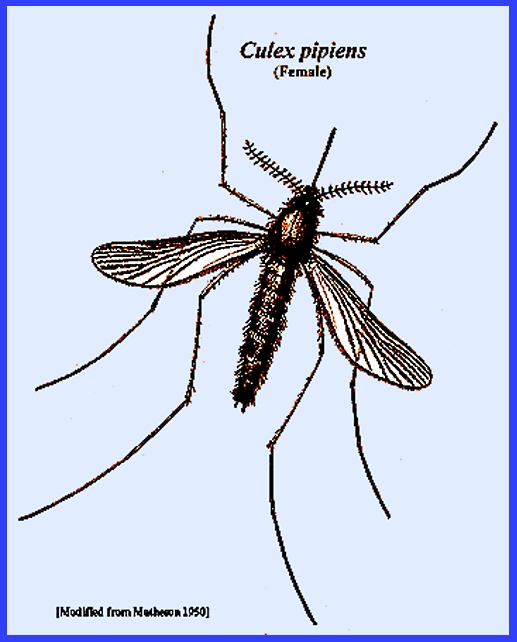File: <westnile.htm> <General Index> Site Description Glossary <Navigate to Home>
|
WEST NILE ENCEPHALITIS (Contact) Please
CLICK on
Image & underlined links for details: Service (2008) reported that the virus is mainly an
infection of birds, with lethality in crows being very high. Recent experiments show that other bird species
will be more efficient reservoir hosts, however. The virus has been isolated from more than 69 mosquito species,
but the Culex pipiens complex, Cx. modestus
and Cx.
univittatus are the most important vectors. There is co-feeding transmission when an
uninfected mosquito is feeding on a host very close to an infected mosquito
the virus from the infected mosquito passes to the uninfected mosquito,
making it a potential vector (Service 2008).
Sometimes a mosquito that feeds on both birds and mammals (i.e., a
"bridge vector") transfers the infection to humans, horses and
other mammals. Mammals are incidental
dead end hosts because they do not have sufficient virus titer to infect
other mammals. Symptoms are typically flu-like, but the duration is
usually less and the fevers, joint aches, etc. are milder. Nevertheless, being a newly invaded virus
it is impossible to determine whether more virulence will be associated with
West Nile. Key References: <medvet.ref.htm> <Hexapoda> Matheson, R. 1950.
Medical Entomology. Comstock
Publ. Co, Inc. 610 p. Service, M. 2008. Medical
Entomology For Students. Cambridge
Univ. Press. 289 p Legner,
E. F. 1995. Biological control of Diptera of medical
and veterinary importance. J. Vector
Ecology 20(1): 59_120. Legner,
E. F.. 2000. Biological control of aquatic
Diptera. p. 847_870. Contributions to a Manual of Palaearctic
Diptera, Vol. 1, Science Herald, Budapest. 978 p. |
